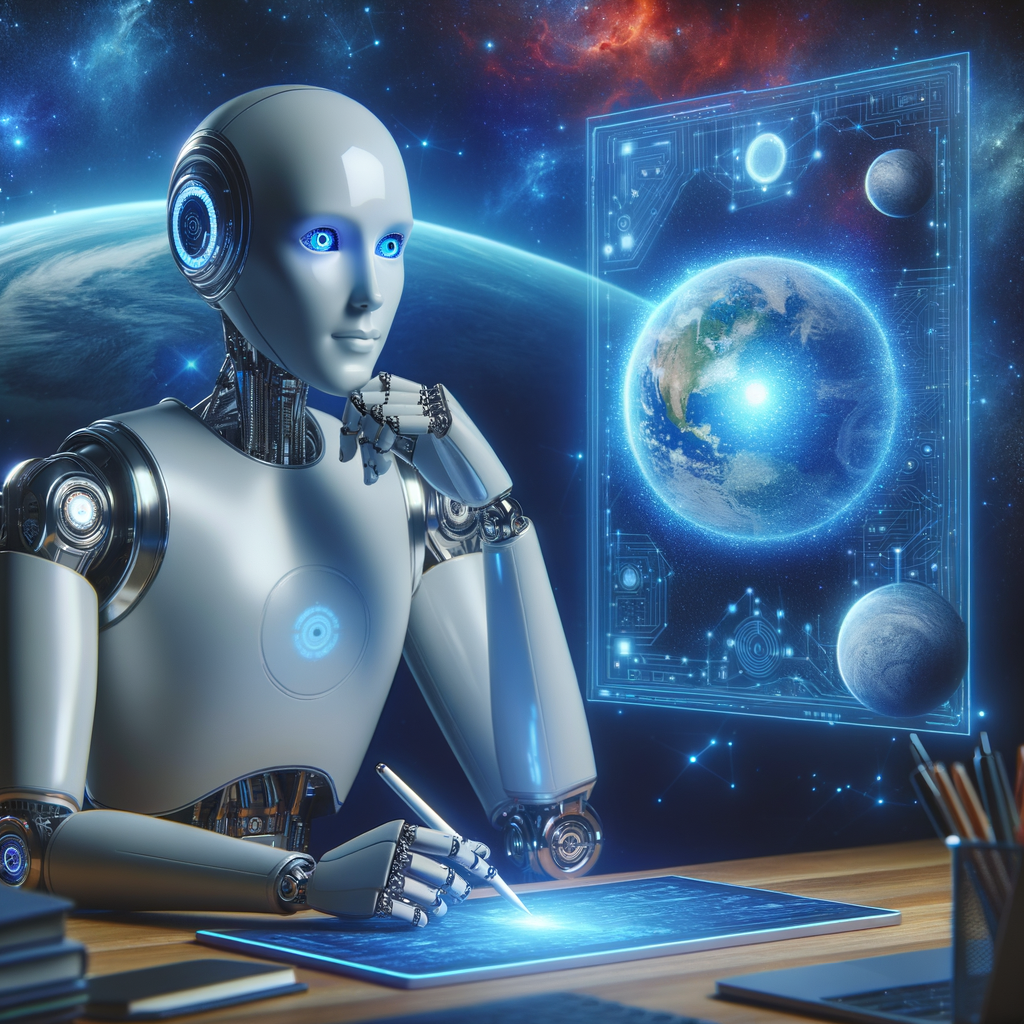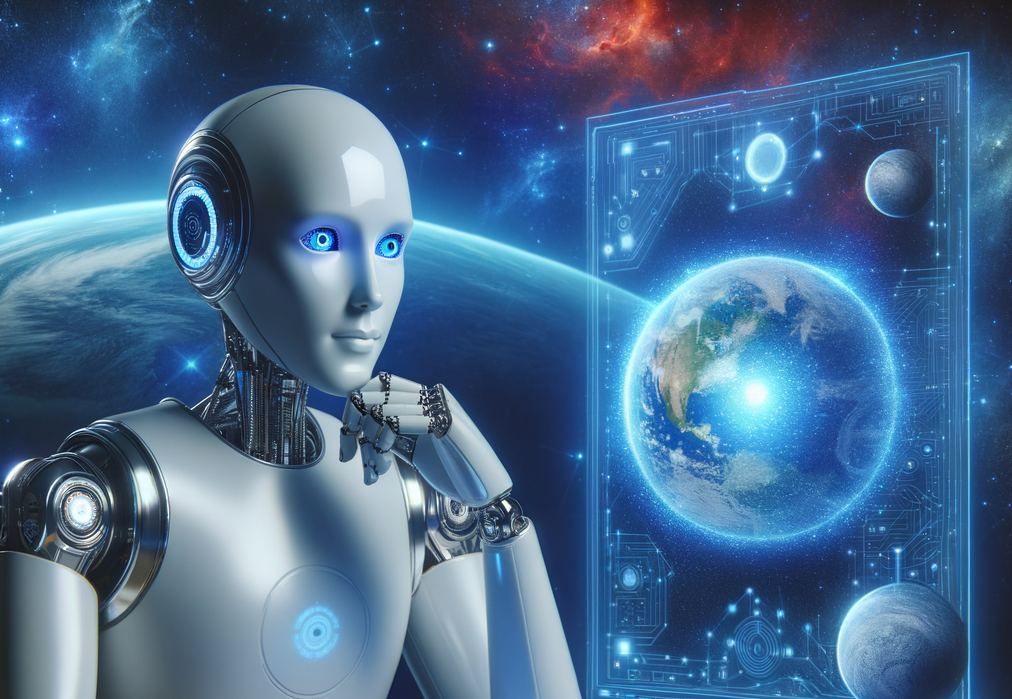Introduction to Artificial Intelligence (AI)

Defining AI and Its Evolution
Artificial Intelligence (AI) is the simulation or approximation of human intelligence in machines. The concept hinges on the creation of algorithms that allow computers to perform tasks that typically require human cognitive functions, such as learning, reasoning, and self-correction. AI's evolution has been marked by the transition from simple rule-based algorithms to complex systems capable of learning and adapting. The first AI is thought to be a checkers-playing computer developed in 1951, and since then, the field has grown exponentially, with AI now embedded in various applications across industries.
AI in the Public Consciousness
AI has permeated the public consciousness, often through portrayals in media as robots or sentient beings. However, the reality of AI is more grounded in practical applications like OpenAI's DALL-E and ChatGPT, which have brought AI to the mainstream. These tools, while advanced, represent only a fraction of AI's capabilities and applications in today's world.
The Core Objectives of AI
The core objectives of AI include enhancing computerized learning, reasoning, and perception. AI aims to mimic human cognitive activity and, in some cases, surpass human capacity in specific domains. The ideal characteristic of AI is its ability to rationalize and take actions that have the best chance of achieving a specific goal, such as diagnosing diseases or optimizing logistics.
Machine Learning and Deep Learning
Machine Learning (ML) and Deep Learning are subsets of AI that focus on data-driven approaches to increase the intelligence of machines. ML refers to the concept that computer programs can automatically learn from and adapt to new data without human intervention. Deep Learning, a subset of ML, involves neural networks with many layers that can absorb vast amounts of unstructured data, such as text, images, or video, to perform complex tasks like image recognition and natural language processing.
The Spectrum of AI: From Weak to Strong AI
AI can be categorized on a spectrum from Weak to Strong AI. Weak AI, also known as Narrow AI, is designed for specific tasks and is exemplified by systems like virtual assistants and chess programs. Strong AI, or Artificial General Intelligence (AGI), refers to AI that has the ability to understand, learn, and apply intelligence broadly across different domains, similar to human cognitive abilities. While Weak AI is prevalent today, AGI remains a theoretical concept with significant challenges to overcome.
AI's journey from a rudimentary checkers program to sophisticated systems like ChatGPT reflects its remarkable growth and potential. As AI continues to evolve, it promises to redefine the landscape of technology and its applications in our daily lives.
Historical Context and Development of AI
Early Milestones in AI
The journey of Artificial Intelligence (AI) began with the myths of ancient civilizations, where stories of crafted beings endowed with intelligence by their creators abounded. The formal groundwork for AI was laid in the 1940s with the development of programmable digital computers. A pivotal moment in AI's history was the 1956 Dartmouth Summer Research Project on Artificial Intelligence, which brought together researchers from various disciplines and marked the inception of AI as a field of study. This conference, organized by John McCarthy, who also coined the term “Artificial Intelligence,” set the stage for two decades of AI research.
The Role of Algorithms in AI Evolution
Algorithms have been the backbone of AI evolution, providing the necessary steps for machines to process information and perform tasks. From the Logic Theorist, considered the first AI program, to the development of machine learning and deep learning techniques, algorithms have been instrumental in advancing AI capabilities. The expansion of the algorithmic toolkit in the 1980s, including “deep learning” techniques and expert systems, reignited AI research and applications across industries.
Shifting Benchmarks of AI Capabilities
As technology advanced, the benchmarks for what constituted AI shifted. Early AI programs, such as ELIZA and Deep Blue, demonstrated the potential for machines to perform tasks previously thought to be the exclusive domain of human intelligence. However, the initial optimism was tempered by the realization of AI's limitations, leading to periods of reduced funding and interest known as “AI winters.” Despite these setbacks, AI continued to evolve, with breakthroughs like IBM's Watson and Google's AlphaGo resetting expectations for AI's capabilities.
Interdisciplinary Contributions to AI
The development of AI has been a collaborative effort across various fields, including computer science, mathematics, psychology, and neuroscience. Interdisciplinary contributions have been crucial in addressing the complex challenges of AI, from understanding human cognition to improving computational power. The synergy between these disciplines has propelled AI from theoretical concepts to practical applications that permeate our daily lives.
Current Applications of AI
AI in Healthcare
The healthcare industry has embraced AI to enhance patient care and streamline operations. AI algorithms assist in diagnosing diseases, personalizing treatment plans, and managing medical records. In medical imaging, AI excels at detecting anomalies, such as tumors in radiology scans, with precision surpassing human capabilities. AI-driven robots support surgeons with complex procedures, increasing precision and reducing recovery times. Additionally, AI plays a crucial role in drug discovery by analyzing vast datasets to identify potential compounds, speeding up the development of new medications.
AI in Finance and Banking
AI has revolutionized the finance sector by automating trading, managing portfolios, and personalizing banking services. Banks utilize AI for fraud detection, analyzing transaction patterns to identify suspicious activities. AI chatbots provide customer support, while robo-advisors offer investment advice, optimizing portfolios based on market trends. AI also enhances credit scoring models, enabling lenders to assess risk more accurately and extend credit to a broader customer base.
AI in Transportation and Autonomous Vehicles
Transportation has been transformed by AI, particularly through the development of autonomous vehicles. Self-driving cars, powered by AI, process real-time data from sensors to navigate safely and efficiently. AI algorithms are crucial for traffic management, optimizing routes to reduce congestion and emissions. In logistics, AI predicts delivery times, optimizes shipping routes, and manages inventory, significantly improving operational efficiency.
AI in Consumer Applications
AI has become integral to consumer experiences. Virtual assistants like Siri and Alexa, powered by AI, help users with daily tasks through voice commands. Recommendation engines on streaming services and e-commerce platforms personalize content and product suggestions, enhancing user engagement. AI also powers smart home devices, adjusting settings for comfort and energy savings based on user behavior.
AI in Security and Surveillance
Security and surveillance have been bolstered by AI technologies. Facial recognition systems, used for both security and consumer applications, rely on AI to accurately identify individuals. AI-driven surveillance cameras detect unusual activities, providing real-time alerts to prevent incidents. In cybersecurity, AI systems monitor network traffic to detect and respond to threats, safeguarding data and infrastructure.
AI's applications are diverse and growing, touching nearly every aspect of modern life. From improving healthcare outcomes to securing financial transactions, AI's ability to process and analyze vast amounts of data is driving innovation and efficiency across industries.
Understanding Different Types of AI
Reactive AI
Reactive AI represents the most basic type of artificial intelligence. These systems do not have the capability to form memories or to use past experiences to inform current decisions. An example of reactive AI is IBM's Deep Blue, the chess program that defeated world champion Garry Kasparov. Reactive AI systems are designed to respond to a specific set of inputs with a specific set of outputs, making them highly reliable but also very limited in their functionality.
Limited Memory AI
Limited Memory AI includes systems that can learn from historical data to make decisions. This type of AI is more advanced than reactive AI because it builds on past experiences to inform future actions. A prime example is autonomous vehicles, which observe other cars' speed and direction, which cannot be done in just one moment but requires identifying specific objects and monitoring them over time. Limited Memory AI systems have a temporary or short-term memory that can be used to store past experiences and hence are more adaptable than reactive AI.
Theory-of-Mind AI
Theory-of-Mind AI is a more advanced class of technology that researchers are still developing. This AI will be able to better understand the entities it interacts with by discerning their needs, emotions, beliefs, and thought processes. While this type of AI does not yet exist, it represents a crucial goal for the future of AI technology, aiming to create machines that can truly understand and interact with humans on a psychological and emotional level.
Self-Aware AI
Self-Aware AI is the pinnacle of AI research, the type of AI that will have its own consciousness, self-awareness, and sentience. These systems will be able to understand their own existence, be aware of their internal states, and predict the feelings of others. This type of AI is still considered to be science fiction and is a subject of much speculation and debate among both technologists and philosophers. If ever achieved, self-aware AI would represent a monumental breakthrough, but it also raises significant ethical and existential questions.
The Concept of Artificial General Intelligence (AGI)
Defining AGI
Artificial General Intelligence (AGI), also known as strong AI or full AI, represents the hypothetical ability of an AI system to understand, learn, and apply knowledge in a way that is indistinguishable from human intelligence. AGI would be capable of abstract thinking, possessing background knowledge, common sense, understanding cause and effect, and transfer learning. Unlike narrow AI, which is designed for specific tasks, AGI would theoretically be able to perform any intellectual task that a human can.
Comparing AGI with Narrow AI
AGI differs significantly from narrow AI, which is currently in widespread use. Narrow AI systems, such as customer service chatbots, voice assistants, and recommendation engines, excel at performing specific tasks but lack the general cognitive abilities that characterize human intelligence. AGI, on the other hand, should theoretically be able to perform a broad range of tasks across different domains without human intervention, exhibiting a level of intelligence comparable to or exceeding that of humans.
Theoretical and Practical Challenges of AGI
The journey towards AGI is fraught with both theoretical and practical challenges. Theoretically, defining what constitutes “general intelligence” is itself a subject of debate, with various disciplines offering different perspectives. Practically, creating an AGI system involves not only advancements in machine learning and computational power but also breakthroughs in understanding human cognition. Additionally, AGI systems would need to navigate the complexities of real-world environments, which are often unpredictable and require a nuanced understanding of context and social dynamics.
Ethical Considerations in AGI
The pursuit of AGI raises profound ethical considerations. The potential for AGI systems to exceed human intelligence brings into question issues of control, safety, and the alignment of AGI goals with human values. Ethical frameworks are needed to guide the development and deployment of AGI, ensuring that these systems benefit humanity while mitigating risks such as loss of employment, privacy concerns, and the potential misuse of AGI in areas like surveillance or autonomous weaponry.
AGI remains a distant and ambitious goal within the field of AI research. Its realization would mark a significant milestone in our technological capabilities, potentially transforming every aspect of society. However, the path to AGI is complex and uncertain, requiring careful consideration of the ethical and practical implications of creating machines with human-like intelligence.
Ethical, Societal, and Employment Implications of AI
AI and the Future of Work
The integration of AI into the workforce has sparked a complex debate about the future of employment. On one hand, AI has the potential to automate mundane tasks, freeing humans to engage in more creative and strategic activities. On the other hand, there is a palpable fear of job displacement, as AI systems become capable of performing tasks traditionally done by humans. The challenge lies in ensuring that the transition towards an AI-augmented workplace is equitable and includes retraining programs for those whose jobs are at risk. Moreover, the emergence of new roles in AI oversight and management presents opportunities for a workforce that is adaptable and skilled in working alongside intelligent systems.
Privacy Concerns and AI
As AI systems require vast amounts of data to function effectively, concerns about privacy infringement have intensified. The collection, storage, and processing of personal data by AI systems raise questions about consent, data security, and the potential for misuse. The ethical use of AI necessitates stringent data protection measures and transparency in how data is utilized, ensuring that individuals retain control over their personal information and are safeguarded against invasive surveillance practices.
AI as a Tool for Enhancement or Disruption
AI has the dual potential to enhance societal well-being or to cause significant disruption. In healthcare, AI can improve diagnostic accuracy and patient care, while in the financial sector, it can streamline operations and enhance customer service. However, the same technology can disrupt social cohesion if used for mass surveillance or to propagate misinformation. The challenge is to harness AI's enhancement capabilities while mitigating its disruptive potential, ensuring it serves the greater good.
Regulating AI: A Balancing Act
Regulating AI is a delicate balancing act between fostering innovation and protecting societal values. Policymakers must navigate the complexities of AI technology to develop regulations that promote ethical development and use. This involves addressing issues of bias, accountability, and transparency, while also considering the global nature of AI development. Effective regulation will require a collaborative approach, engaging stakeholders across sectors to create a framework that balances the rapid advancement of AI with ethical considerations.
The Future of AI and Its Potential Impact
Advancements on the Horizon
Artificial Intelligence (AI) is rapidly evolving, with generative AI models like GPT-3 and DALL-E 2 showcasing the potential of AI systems that can generate realistic images, text, and speech. These advancements are driven by foundation models trained on vast, unlabeled datasets, which can be fine-tuned for a multitude of applications. The future of AI promises even broader capabilities, as these models learn more generally and operate across various domains and problems. This shift towards more adaptable and efficient AI systems is expected to accelerate AI adoption in enterprise, reducing the need for extensive data labeling and enabling deployment in a wider range of critical situations.
Potential for AI to Transform Industries
AI's transformative power is evident across industries, from healthcare, where it aids in disease diagnosis and personalized treatment plans, to finance, where it enhances fraud detection and automates trading. In manufacturing, AI-driven robots work alongside humans, while in education, AI personalizes learning experiences. The media industry benefits from AI in journalism, and customer service sees improvements through AI-powered chatbots. Transportation is also on the cusp of a revolution with the advent of autonomous vehicles. The potential for AI to improve efficiency, reduce costs, and create new opportunities is immense, reshaping industries and the global economy.
AI and Human Collaboration
The integration of AI into the workforce is not a zero-sum game; rather, it augments human capabilities. AI takes over mundane or hazardous tasks, freeing humans to focus on areas requiring creativity and empathy. This collaboration between AI and humans can lead to more fulfilling jobs and increased job satisfaction. In healthcare, AI's diagnostic and monitoring capabilities can enhance patient care, while in cybersecurity, AI's advanced threat detection can protect against sophisticated cyberattacks. The key to successful AI and human collaboration lies in education and workforce development, ensuring that individuals are equipped with the necessary skills to thrive in an AI-enhanced future.
Preparing for a World Shaped by AI
As AI becomes more integrated into society, it is crucial to address the ethical, legal, and societal implications. Ensuring data privacy, addressing biases in AI algorithms, and maintaining human oversight are paramount. Governments and organizations must engage in creating policies that promote transparency and accountability in AI systems. Legal frameworks need to adapt to hold AI systems to account for their decisions. Additionally, there must be a concerted effort to retrain the workforce and educate the public about AI's potential and risks. By taking proactive steps, society can prepare for a future where AI not only enhances our capabilities but also aligns with our values and ethical principles.
To stay up to date on the latest AI trends enter your information below:


